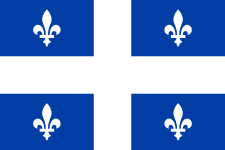The Air Quality data for Montreal and Quebec has been available for a while, but we recently got few questions about the AQI scale used in this part of Canada. One of them is from Marie A., who asked:
I would like to know why the Air Quality Index on your web site is different from the AQI on the Montreal's website? Do you recalculate anything to meet the US EPA AQI standards? If so, how? With what data?
For example, date July 14th 2:00pm, most of the indexes on your website range from 53 to 65 (one index is 37) and it is supposed to be realtime AQI. On the website of Montreal city, date July 14th 2:00pm, most of indexes range from 16 to 37 and it is realtime AQI as well.
So, can you explain me the difference and what the standards details you are using?
This is indeed a very good question. and we will explain in this article the different scales in use, how the scales compare to each other, and how the convertion can be done.
oOo
As we explained in one of our previous articles, all the AQI figures published on the World Air Quality Index project are currently [1] using the US EPA standard. Neither Montreal nor Quebec are expection to this rule, so this confirms that the values displayed on the page city/montreal are using the US EPA standard.
This is the reason for the difference between the World Air Quality Index project readings and the Montreal city website ( montreal.qc.ca): The Montreal city EPA (Environment Protection Agency) is using its own proper AQI scale, which is clearly described on the same website. To make it slighly more "complex", Quebec is actually using another AQI scale (specified at this link) compared to Montreal (tabarnac!). And of course, Canada is using yet another scale, called AQHI for Air Quality Health Index - but that's something we already wrote about in another article.
The summary of Montreal and Quebec AQI breakpoints are listed in this table:
| Pollutant | Quebec | Montreal | ||
|---|---|---|---|---|
| Averaging Period | Reference Value | Averaging Period | Reference Value | |
| Fine Particles (PM2.5) | 3 hours | 35µg/m3 | 3 hours | 35µg/m3 |
| Ozone (O3) | 1 hour | 82 ppb | 1 hour | 160 µg/m3 |
| Nitrogen dioxide (NO2) | 1 hour | 213 ppb | 1 hour | 400 µg/m3 |
| Sulfur dioxide (SO2) | 4 minutes mobile | 213 ppb | 10 minutes mobile | 500 µg/m3 |
| Carbon monoxide (CO) | 1 hour | 30 ppm | 1 hour | 35 µg/m3 |
oOo
In order to convert the values to the US EPA standard, the raw concentrations expressed in milligrams or ppb/ppm (particle count per billion/million) are required.
Unfortunately, neither Montreal nor Quebec county is providing those raw concentrations. Instead they are only providing the Air Quality readings already converted to their own respective AQI scales. But this actually not a problem, since the re-conversion to concentration can be done using this simple linear formula:
Raw concentration (pollutant) = Reference value (pollutant) * AQI }(pollutant) / 50For instance, if an PM2.5 AQI value of 18 is published on Montreal city website, then the raw concentration in milligrams is 18*35/50 = 12.6 mg/m3. Note that for Ozone, CO, SO2 and NO2 the unit is different for Quebec and Montreal (ppb for Quebec - US standard, and mg for Montreal EU standard), but that is just an additional conversion (partly explained in this article).
Note that the PM2.5 AQI is based on 3-hours average, while on the World Air Quality Index project, the hourly PM2.5 Instant Cast AQI reporting is used. Since it is not possible to deduct the hourly data from the 3 hours average, this actually means that the PM2.5 AQI reported on the World Air Quality Index project for Montreal and Quebec is not exactly an "Instant Cast" reporting.
oOo
So, last, here is the visual comparison of 3 AQI scales (US EPA, Quebec and Montreal) for PM2.5 and Ozone (note that for Ozone, the ppm unit is used - so the conversion from mg to ppm is done for Montreal).
One interesting point to notice is that both Quebec and Montreal are using the AQI value of 25 as the breakpoint between Good (green) and Acceptable (yellow), while for the US EPA, this breakpoint is set at 50. So, all in all, when comparing apple-to-apple with the right conversion and breakpoints in mind, the reported AQI range is very similar between the US EPA standard and Quebec / Montreal standards.
--
For more information about specific countries or continent, please refer to those articles: Thailand and Malysia - India - China - Hong Kong / Canada (Air Quality Health Index) - South America - Australia - Quebec and Montreal - Singapore - Poland - Indonesia .
For information about the 24 hours averaging used or Ozone and Particulate Matter (PM2.5), please refer to those two articles: Ground Ozone Index - PM2.5 Instant Cast

